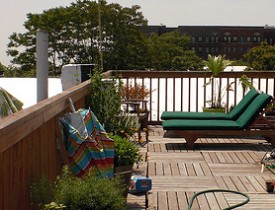Three Reasons Why Rooftop Decks are Complicated to Build
 Every few years a news story pops up about some building that has collapsed due to snow load on its flat roof. So when a homeowner thinks about adding a rooftop deck, scary images of these winter disasters should come to mind. If you are thinking about adding a roof top deck, you will need to consider the following issues.
Every few years a news story pops up about some building that has collapsed due to snow load on its flat roof. So when a homeowner thinks about adding a rooftop deck, scary images of these winter disasters should come to mind. If you are thinking about adding a roof top deck, you will need to consider the following issues.
Issue #1: Access
A deck on your roof is possible if you have handy and convenient access. To make the space usable and practical, a direct access route to the roof is required. Nobody wants to have to climb a ladder to use a space, and carrying items up and down a ladder is ill advised. Even a lightweight lawn chair and a tall glass of iced tea would make negotiating a ladder unsafe. The choice to built a deck should exclude all those locations that do not have a handy access route.
Issue #2: Load Bearing Capacity
The next biggest problem has to deal with weight and loading. In the world of home building and deck building, loads are broken down into categories:
- Dead load
- Live load
- Dynamic load.
Dead load is the weight of the parts that make up the structure. This is the weight of the framing, drywall, carpet, deck boards, etc. Live loads are a variable component, like people, furniture, BBQ grills, and flower pots. Dynamic loads, also variable, usually relate to your location and include wind and snow loads.
The IRC (2006) International Residence Code has minimum live loads for flat roofs set at 20 psf and for decks at 40 psf. Both of these have dead loads of 10 psf. Snow and wind loads are added to these based on local conditions. Basic limited storage attics or typical flat roof specifications do not meet the minimum requirement for a deck; in fact they are at 50% of that minimum. So the take home message is: Unless you have a roof system that has been designed to function as a “deck,” it should not be used as one. If you happen to live in a snowy region and have a flat roof that is designed for snow loads greater than 50 psf, then you could build and set up a rooftop deck.
Issue #3: Materials Routing
While getting to the roof deck may be fairly easy for people and a few deck chairs, transporting 12- to 16-foot long lumber may be an entirely more complex issue. Many urban dwellers live in multi-unit buildings that are many stories tall. The challenge of getting large quantities of building materials up six flights of stairs to this location may be too extreme. Most elevators cannot handle a 12’ long 2 x 8 deck joist. It is possible to build using shorter lengths of lumber, but working with long lengths makes deck building much quicker and easier.
Consult with a qualified contractor to see whether your roof is right for a deck.
Updated December 11, 2017.
Looking for a Pro? Call us (866) 441-6648

Roofing Average Costs
Roofers Experiences

Kitchen Remodel: More Space And A Cozy Family Hangout

Deck Repair On A Deadline



